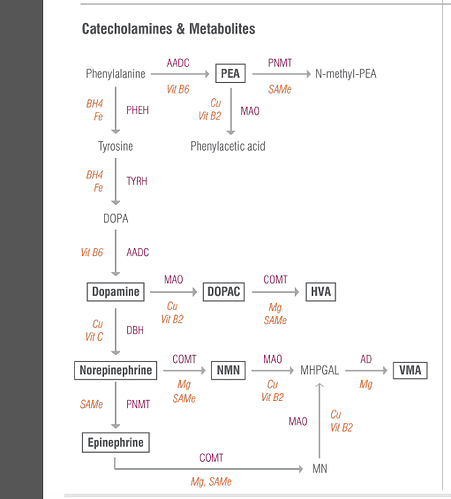CCC and I touched on this in a PM exchange. I wanted to post a topic to get thoughts.
The most recent Dr Melcangi study showed that Finasteride lowered an enzyme actvity (PNMT) that converts nor-epinephrine into epinephrine.
“In support of our hypothesis, results revealed a reduction in the levels of epinephrine, with a concomitant increase of norepinephrine levels, coupled to no effect on PNMT protein levels. These findings suggest that the altered hormonal levels were due to a reduction of the enzymatic activity rather than to decreased levels of PNMT.”
"We believe that the present findings may help in explaining the various side effects reported by FIN users, in particular those related to sexual function "
" The noradrenergic system is also involved in the regulation of male sexual functions.[(50,51) The central control of erection is linked to ascending signals to the brain and descending ones to the spinal cord.[(51)]In addition, adrenergic innervation is strongly present in penile arteries and veins and in cavernosal smooth muscle.[(52)] In support, vascular control by the autonomic nervous system regulates erection.[(53)] The first phase of the erection cycle in humans is the flaccid state; then, upon stimuli, the penis reaches tumescence until complete rigidity, to conclude with the detumescence phase, back to the initial flaccid condition. Adrenergic control is involved in all erection phases.[(54)] Indeed, norepinephrine release in the penis induces the flaccid state by contracting the trabecular smooth muscle.[(55)]( Accordingly, in healthy men, a reduction in norepinephrine levels is associated with penile tumescence and erection, while an increased level of this hormone is associated with the transition from rigidity to detumescence.[(26)]Thus, norepinephrine is involved in transforming the penis from the erect to flaccid state.[(56)]In contrast to norepinephrine, epinephrine levels are increased in the tumescence phase in relation to the flaccid condition and then decreased in the rigid and detumescence phases.[(27)]Thus, these two hormones have opposite functions in penile erection. In human psychogenic and neurogenic erectile dysfunctions, the rigidity phase cannot be achieved. Interestingly, in these conditions, plasma norepinephrine levels are high in flaccidity, tumescence and detumescence phases, suggesting an impairment in adrenergic signals.[(27)] In summary, the balance of epinephrine and norepinephrine is crucial for achieving an erection.[(76,77)] Thus, based on the results we obtained, it is possible that FIN administration, by affecting PNMT enzymatic activity, is involved in the sexual problems reported by FIN users."
https://pubs.acs.org/doi/10.1021/acs.jmedchem.0c02039?ref=pdf
This microdosing approach having any efficacy comes with major assumptions,
this adrenergic imbalance decribed above continues post withdraw of Fin. (aka continues with PFS).
- that microdosing epinephrine creates enough of a counter ratio in different conditions to mimic physiological ratios in “normal men”…
- normal baseline state (may need a smaller microdose to help attention, memory, other cognitive functions)
- “excitement” / tumescence phase (may need a larger microdose to “help” create the engorgement and “excitement” when sexual stimulation begins)
- the wild car here, is that because its exogenous epinephrine, norepinephrine continues to be presumably remain high (not enough is turning over into norepinephrine). *norepinephrine release in the penis induces the flaccid state by contracting the trabecular smooth muscle.[(55)] Accordingly, in healthy men, a reduction in norepinephrine levels is associated with penile tumescence and erection, while an increased level of this hormone is associated with the transition from rigidity to detumescence. > This could cause an issue where continued high levels of NE “bocks” the actions of raise E.
I have 45-60 days before I get a penile implant. Any help getting my hands on a vial of epinephine (not an epi-pen though) would be greatly appreciated!

 -
-